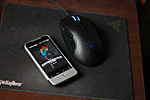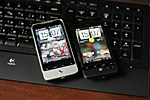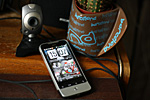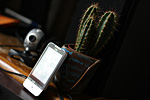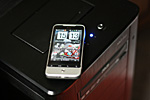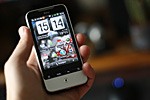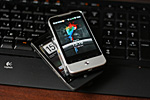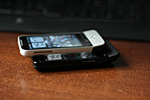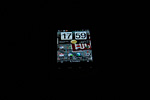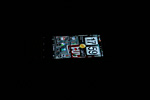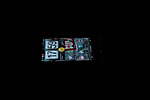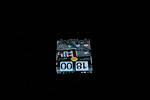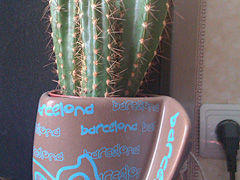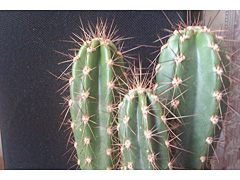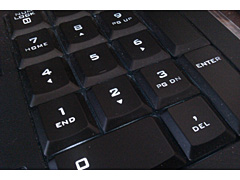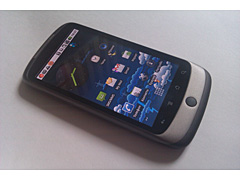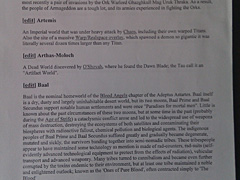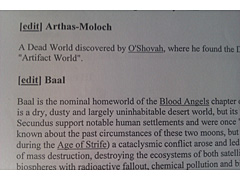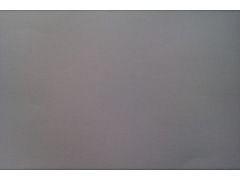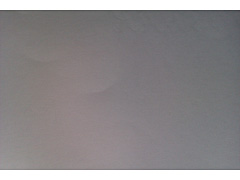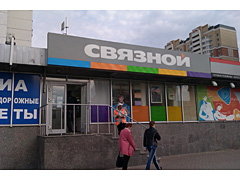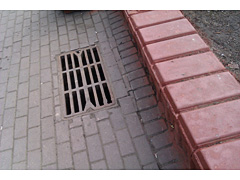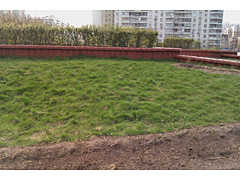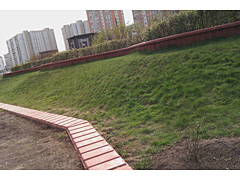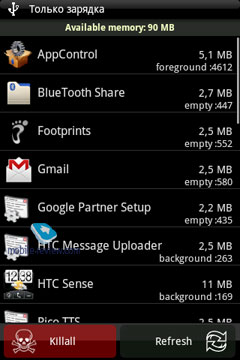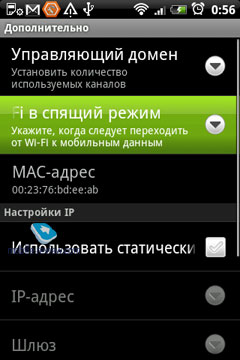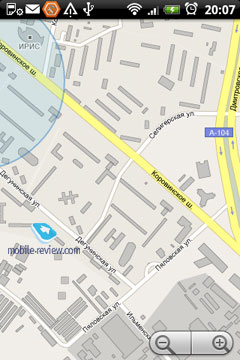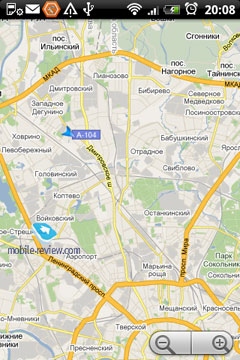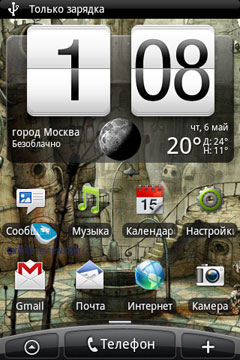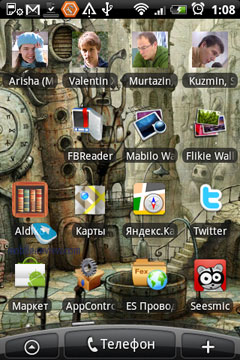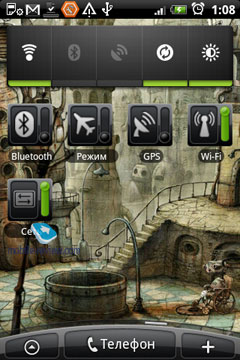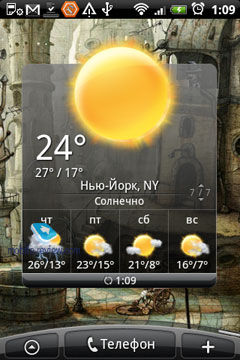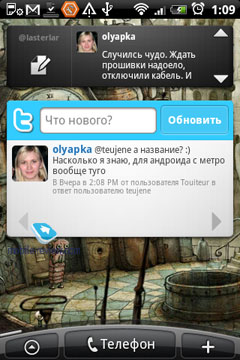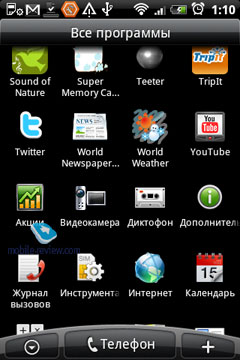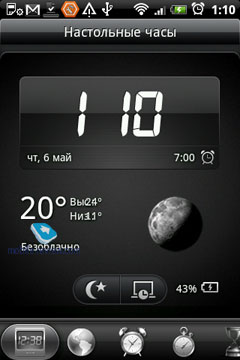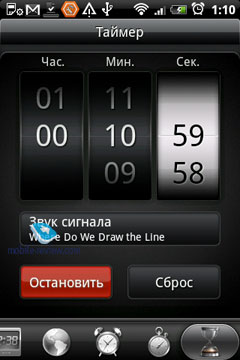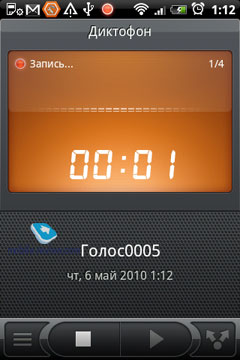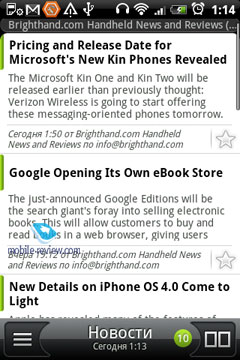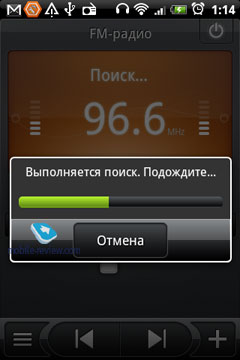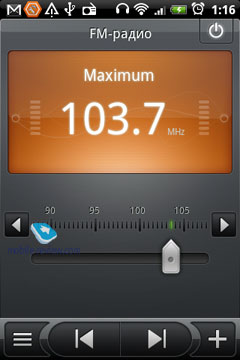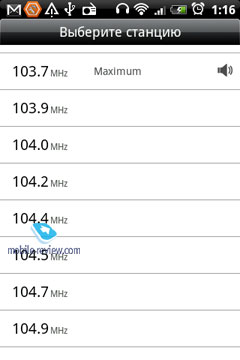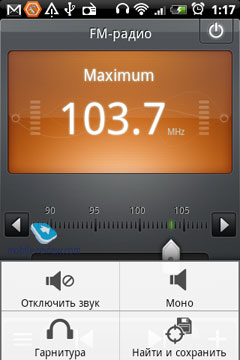HTC Legend GSM/UMTS Smartphone Review
Live photos of HTC Legend
Contents:
- Positioning
- Design, materials
- Size
- Controls
- Display
- Camera
- Battery
- Performance
- Connectivity
- Navigation
- Sound
- Software
- FM Radio
- Competitors
- Conclusion
Positioning
After the success of HTC Hero the company had two ways to go. First – by all possible means to prolong Hero’s life by releasing it in new colors, special accessories exclusively for the model, constant software updates or new versions of the OS. Unfortunately, today we can say for sure that HTC has forgone this way as a delay, or, to be precise, a double delay of Android 2.1 release for the Hero demonstrates so clearly. The company opted for the second way – to create a smartphone similar to Hero with a number of improvements and changes made. I.e. HTC decided to eliminate mistakes made in Hero in the shortest time and present a new device that is meant to pick up Hero’s successful sales and at the same time to drive it out of the market.

There is nothing strange about this choice. The company decided that if the support of the already released product and the creation of a new, improved one require comparable resources, it would be reasonable to choose the second way. In this case Hero’s life (reincarnated in the Legend) will be prolonged not for just 4-6 months, which could have been achieved if the company chose the first way, but for a year or even longer. The outlook is really cheerful both for HTC as a manufacturer (the Legend is built on the similar platform, hardware and possesses many other similar parts, so the process of the device development was not too difficult) and for the resellers of its devices as the Legend exploits Hero’s success and is positioned as its sequel.
The Legend is a direct development of the Hero, its sequel and twin in many aspects - the device belongs to the medium price segment, to the top of this segment to be exact, as it is offered for the money close to what is asked for the flagships. What new can be found in the Legend compared to the Hero and how smart is the replacement of a “hero” for a “legend”? We’ll talk about this as well as about all the Legend’s specifics below.
Back to the table of contents >>>
Design, materials
The device comes in silver color due to the frame made of aluminum. The model looks the same as HTC Hero – similar form, size and the curved lip in the lower part of the casing, only the keys and the materials changed.


You may wonder if Legend looks more expensive than Hero thanks to the use of aluminum? I think no, it is just different. Just like that you cannot compare Vertu with Mobiado. Both are expensive, positioned on the luxury market, but they differ in the materials used, possible conditions of use. Here the situation is similar. Yes, the Hero was made of usual plastic covered with soft touch paint and the Legend is a solid piece of aluminum. But this fact doesn’t add more points to the Legend, it just allows to call it more flashy. I will explain why.

Shape wise the Hero and the Legend are twins, but the latter is made of a solid piece of aluminum except two areas. The upper edge on the battery side houses plastic insert to avoid problems with wireless interfaces (Wi-Fi, Bluetooth, GPS). You can see a similar plastic insert in the casing’s lower part, covering the battery section and slots for the SIM and memory cards. This insert also contains the antennas for 2G/3G signal, so with the cover removed phone functions are not available (other wireless modules –Wi-Fi, GPS – keep on working). To take the battery out you should remove the plastic cover, then flip a plate and the battery just falls out. Right under the battery you see the slots for both SIM and memory cards. Both cards get fixed after you put them in, press and hear the typical click. To take the cards out is not an easy thing: I, for instance, did it by pushing them in with the pen tip as nails didn’t help. Of course, hot swap feature is not supported. To take the card out or to put it in you should lift the plate up and once it’s done the battery detaches from contacts. By the way, the Hero does support hot swapping.







The openings in the upper plastic insert are not just a design element, they are there as a part of various wireless interface antennas.

Besides shortcomings such aluminum construction has positive sides. First of all, with it we get almost monolithic casing. It has no loose elements and parts that with time will become loose. The mounting of the lower plastic cover is very reliable; it will not get loose even after the long use. Should the phone fall, the cover remains on its place. Of course, you can throw the phone to make the cover fly, but I dropped the Legend on the floor several times - it remained where it should be.

One more advantage of the aluminum case is its insusceptibility to dirt. Traces and fingerprints are not noticeable at all, the dust gathers on the device surface, but there are only a few gaps where it could be collected - camera lens and holes in the top plastic plate.

As good as the case is with the dirt it is awful with scratches. Should you carry the device with keys or the like, throw it into a pocket of backpack where you have lots of coins, the casing will be gradually covered with a net of tiny scratches and chafes. My sample was scratched when I touched it with a tip of one of my keys while taking them out of the pocket. On the pictures it is barely noticeable, but in reality it catches the eye easily, damping my mood. So aluminum casing turns out to be far more fragile than a matte one or one with only few metal elements. I don’t mean that the Legend is hopelessly fragile, but you should note that it isn’t more reliable than any other plastic bodied device and that model’s casing made of aluminum gives your no benefit from the practical point of view.

The device has almost no problems with build quality. It would have been strange for a smartphone made of aluminum and with a minimal number of external parts to have such problems. But there is one thing you could complain about – it is related to the battery cover. In some samples of the Legend the cover was not firmly attached to the casing, it touched only one edge (usually the right one, looking from the device’s back). The gap between the cover and aluminum case can reach 1 mm which is a lot, even half of a millimeter is rather noticeable. Before purchasing the Legend I recommend you to examine smartphones’ rear carefully and pay special attention to the battery cover mounting. You’d better try to move it in the closed state and make sure that the cover sits firmly and exposes no gap.
Back to the table of contents >>>
Size
In terms of size the Legend and the Hero are almost twins, the former is a bit thinner and more elegant shape wise. You can see the dimensions looking at the numbers below and pictures, and compare Legend with other smartphones.
- HTC Legend – 112 x 56,5 x 11,5 mm, 126 g
- HTC Hero – 112 x 56,2 x 14,3 mm, 135 g
- Apple iPhone 3GS – 115,5 x 62,1 x 12,3 mm, 135 g
- HTC Desire – 119 x 60 x 12 mm, 135 g
- Sony Ericsson X10 – 119 x 63 x 13 mm, 135 g
- HTC HD2 – 120,5 x 67 x 11 mm, 157 g





The device is comfortable to carry in a trousers or jeans pocket as well as in a breast pocket, nothing prevents you from placing it in your bag – you are free to do as you please.

As for the comfort of device “grab” during a conversation, IMHO the aluminum casing does more bad than good. Of course, the device doesn’t slip out of your hands, but you don’t feel safe holding it. I don’t know why - probably we are used to matte and rubberized surfaces or the aluminum in the Legend is smooth, which is unusual. In a word, I had to get accustomed to the device material, as for you, check the convenience of the Legend in a store.
Back to the table of contents >>>
Controls
Unlike the Hero where a combination of hardware buttons and a trackball was used, the Legend is controlled via the buttons and optical trackball hereinafter referred to as touchpad. The touchpad in the Legend uses the same control algorithm as the HTC Desire. A few words (or rather sentences) about the optical trackball and ease of its use from our HTC Desire review: “The advocates of justice on our forum blame HTC: they have just got accustomed to a trackball in HTC Hero and Google Nexus One and these bad Taiwanese ruined everything by replaced the trackball with a touchpad. What can I say here? On one side, both trackball and touchpad are exotic and require some time to get used to. On the other side, trackball had certain problems in terms of wear and tear. Many users complained about trackball broken and ceasing to process scrolling on the sides (in my Hero scrolling up didn’t work for a week, then it began to work as suddenly as it stopped).”


What is there to add? IMHO the touchpad is quite comfortable, but requires getting used to. Should I be asked which of the two is more convenient to me I would say that in terms of logic, the touchpad is more convenient and more practical, firstly due to the type and control mechanism being familiar to those using touchpad; secondly, nothing protrudes and you won’t touch it accidentally; you should actually run your finger across it to do anything. Thirdly, it is simple – you just move your finger in the small area scrolling the pages on the display, surfing the menu, etc. From the comfort point of view I would choose the trackball. It is easier to get used to it, and it’s a real pleasure to twist the actual ball for a change instead of moving the finger over another touchpad without any real response. But, I repeat, I have nothing against touchpad implementation in the Legend; it is the same as in the Desire, as far as comfort goes.


By the way, the touchpad in the Legend is combined with a functional button (per se it is a functional button). By pressing it you confirm your actions in the menu or enter the menu item. Pressing the touchpad you are also free to open links, select and launch apps and so on. In other words, it is the most usual press of a central key. Touchpad area in the Legend is really large: about half of a centimeter up and down and the whole area up to the device sides is free and can be used by the finger while you are running it over touchpad.
Now let’s look at the buttons above the touchpad. They are made in a single block with two left buttons separate as there is a space between them, while the third and the forth keys are combined in one button. The leftmost key (Home) is to return to the main screen or to bring up the window with 6 apps launched (you should press and hold it to get there), next to it is the dedicated Menu button that brings up context menu (by holding it you can either open or close the screen keyboard), and then a combined Back and Search button. It’s a pity that by following the latest trend HTC forgone the call receive/reject buttons. They were so good in HTC Hero and made me really happy. And the Legend deprived of these keys has become colder. I think you will understand.

The keys are bigger in size then those of the Hero, due to good travel (which was minimal in the Hero) and clicks accompanying each press, they are a pleasure to work with. In the darkness the keypad is lit with soft white light. In the daylight the backlighting is switched off (thanks to the light sensor.)
The upper part of the fascia plays host to the speaker covered with a grill. Right to the speaker’s grill you can find light and proximity sensors. The light sensor is used for automatic adjustment of display brightness and for turning off/on keys backlighting. With the proximity sensor the display is switched off during the conversation when you put the Legend close to your ear; when you move the device away the backlighting will be enabled again.

In the left of the speaker grill, just under it, is a light indicator. It is orange when the device is being charged or connected to a PC and twinkles when the charge is too low; when charging is complete the indicator turns green. Should there be new messages, missed calls, new letters, SMS or something else assigned to it, the indicator will twinkle green. The indicator doesn’t show wireless interface status.
The left side of the smartphone hosts the thin volume rocker (judging by touch it is made of plastic looking like metal). The button is comfortable to use, your finger will easily find it during a call, for instance. It also makes possible to adjust music player volume without taking the device out of the pocket and turning the display on.

The right side is not utilized, the bottom houses universal a microUSB slot for a charger and cable, microphone hole and a carrying strap loop. The top side is occupied by a 3.5 mm audio jack for a headset and headphones as well as display power button. Should you depress and hold this key for a couple of seconds you will open the pop-up menu offering you to turn the phone Off, enable silent mode, vibrating alert or Flight mode as well as to disable data transfer - useful when roaming.

The 3.5 mm jack in the Legend is located evenly, so when the headphones are plugged in you see no parts of it like it was in the Hero.

The Legend lacks the dedicated camera shutter button. To launch a camera you have to press the camera icon in the menu and use touchpad or screen for shooting and focusing. Also you may just point the handset at the object you choose and wait for 1-2 seconds for autofocus to work its magic.
Back to the table of contents >>>
Display
The legend uses capacitive AMOLED display with 3.2” diagonal with 480x320 resolution (HVGA). The display is really bright and has contrast typical for this type of LCD. Of course, in terms of picture quality it is inferior to WVGA displays in HTC Desire, Google Nexus One, Motorola Milestone and Sony Ericsson X10.
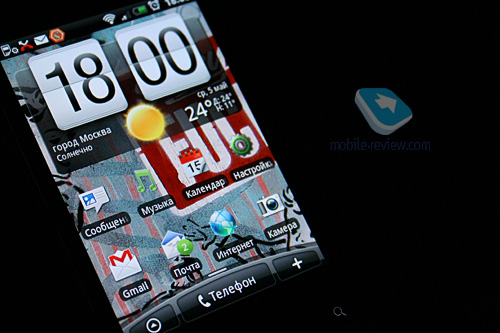
Viewing angles are great, even at considerable deviation the picture doesn’t get distorted.
Legend’s display is covered with protective glass (special polymer similar to that used in HTC Desire and Google Nexus One). Thanks to this material the display surface is not susceptible to scratches; the traces and fingerprints are barely noticeable.

With the brightness level set at the maximum level the display is more or less legible in the sun, although it fades. At the minimal brightness you can read books, although for me the brightness of AMOLED displays is too high for comfortable reading even at a minimal level. This situation is somewhat improved by the use of white font on black background. On the pictures you can see HTC Legend’s display with both minimum (set to zero) and maximum levels of brightness.

Maximum level of display brightness
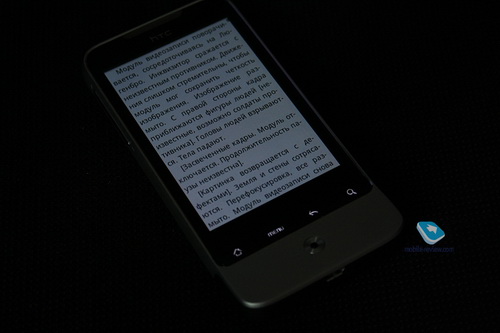
and minimum
For the sake of comparison I offer you the pictures with FBReader running on Legend and Hero: the Legend is on the left and the Hero - on the right:
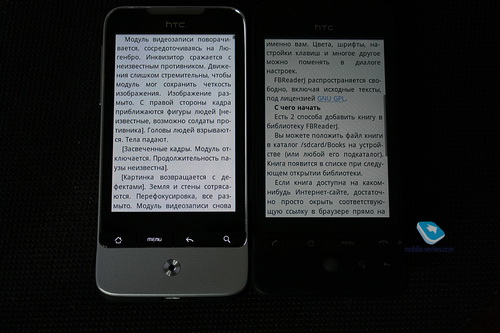
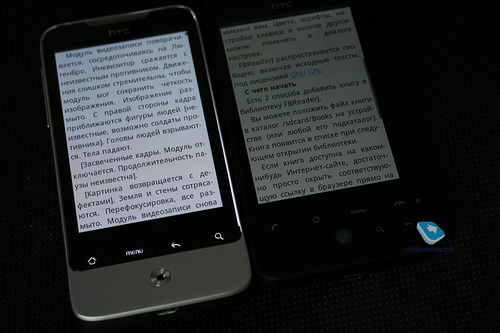
Maximum level of display brightness
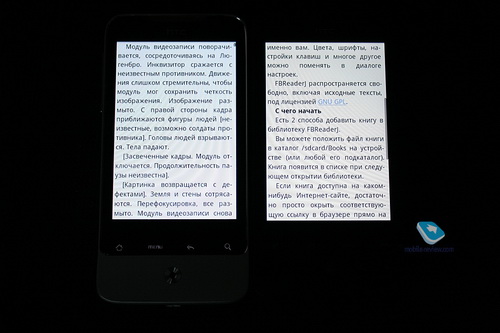
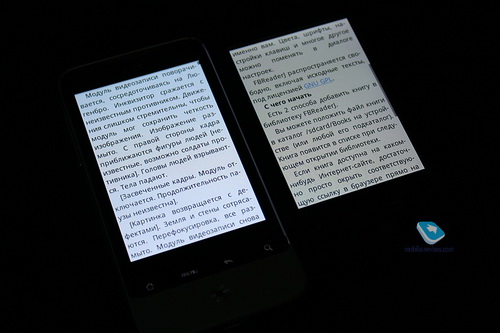
and minimum
As all capacitive displays Legend screen responds great to a finger, you won’t be able to control the device via stylus, pencil or things of that kind.
Automatic brightness adjustment works surprisingly well (earlier I always complained about it), the system changes the brightness according to light conditions. I won’t say about how much the Legend’s display is comparable with that of Nexus One and how much it is brighter or bleaker that Hero’s display, you can assess the display quality on the pictures below:
Displays comparison: HTC Legend vs. HTC Hero (Legend above):

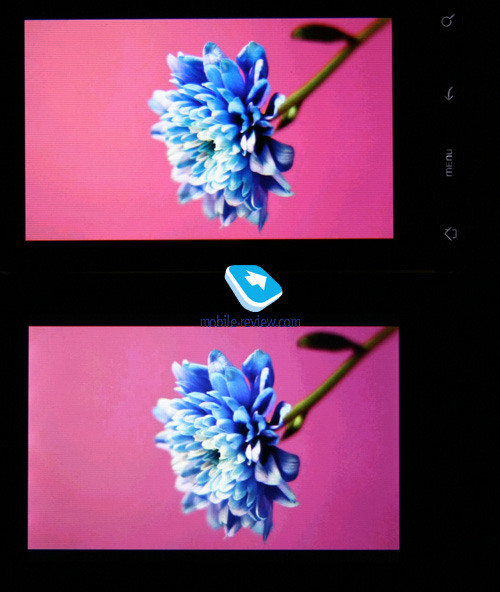
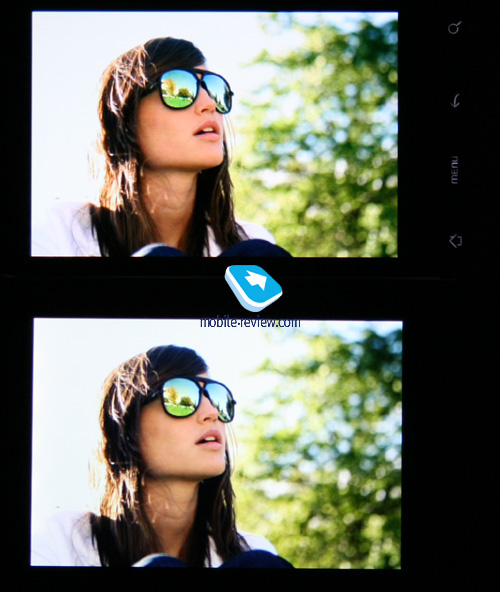

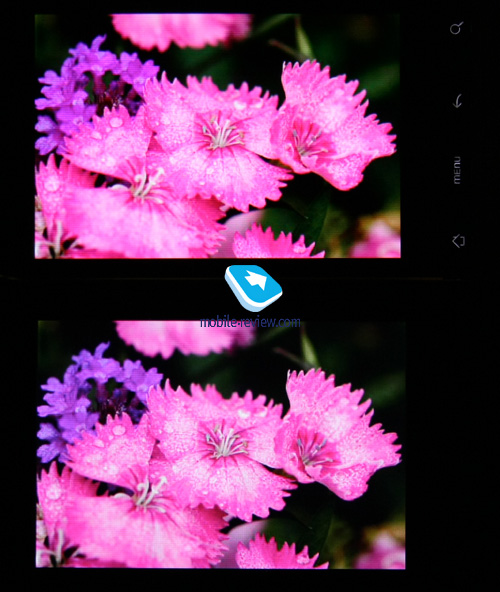
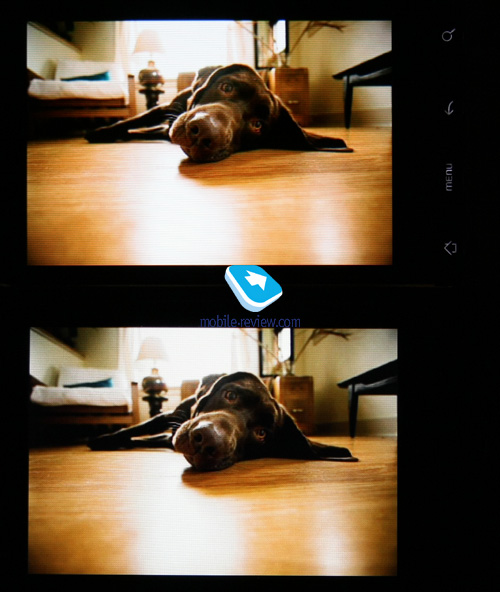

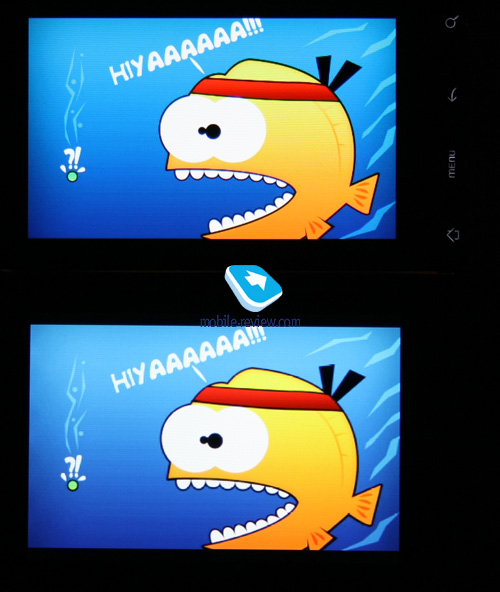
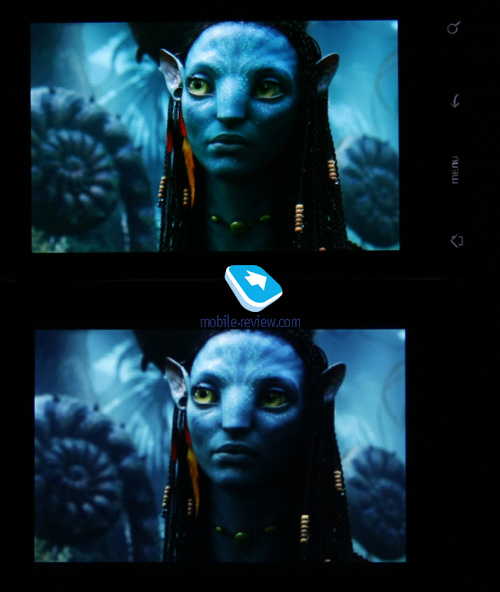
Displays comparison HTC Legend vs. Google Nexus One (Legend above):
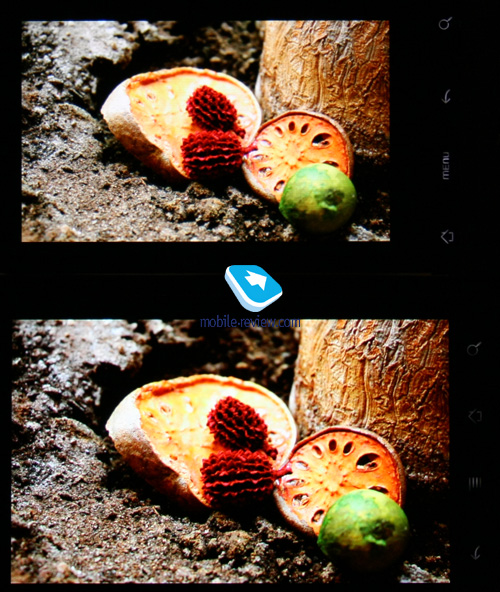
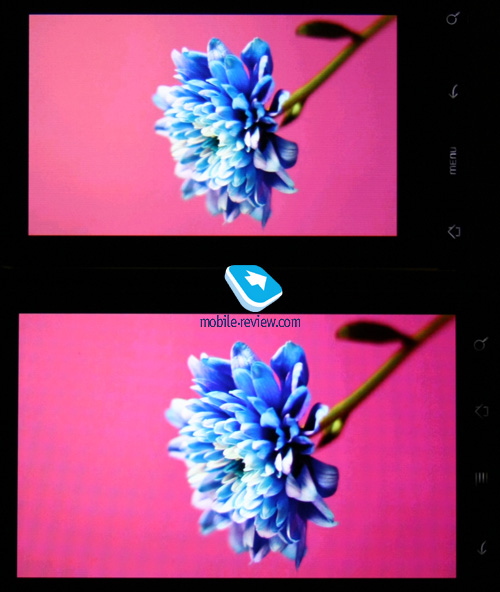
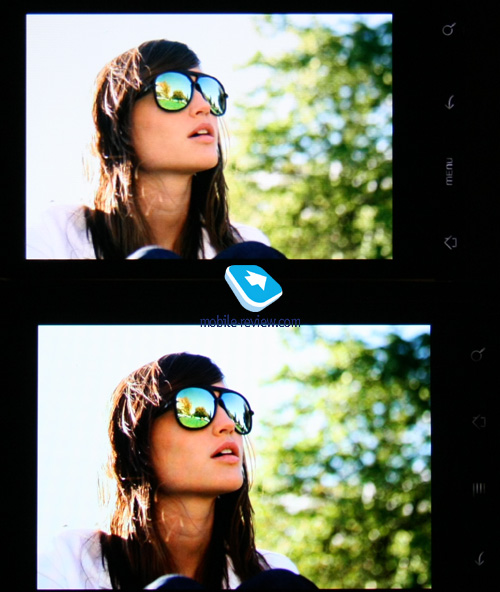



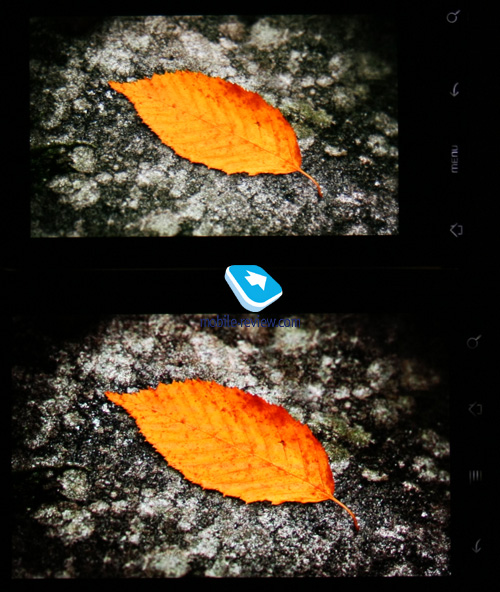
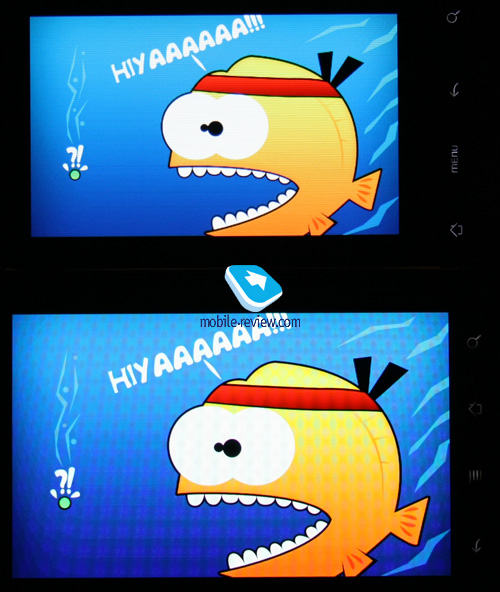

Back to the table of contents >>>
Camera
The communicator carries 5MPx camera with autofocus and LED flash onboard. Camera lens is placed in the upper part of the back located at surface level and rimmed with metal. The flash is a bit below.

In viewfinder mode the display shows flash mode and zoom condition as well as the gallery entry icon. To bring up the settings you have to press the slider on the left or the Menu button under the screen. Once done the Settings menu appears in the left side of LCD, some options are selected in pop-up windows.
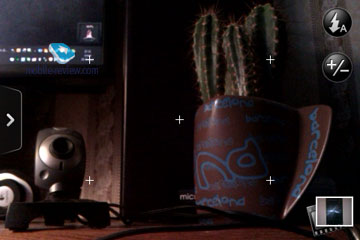

The following standard and widescreen (aspect ratio 3:2) resolutions are available:
- 5M (Wide) – 2592x1728
- 5M – 2592x1952
- 3M (Wide) – 2048x1360
- 3M – 2048x1536
- 1M (Wide) – 1280x848
- 1M – 1280x960
- Economy (Wide) – 640x416
- Economy – 640x480

Pictures quality (mainly expressed in the size of the picture):
Balance of White:
- Auto
- Incandescent lamp
- Fluorescent lamp
- Daylight
- Cloudy
Effects:
- Grey shadows
- Sepia
- Negative
- Solarium
- Pasteurization
- Blue
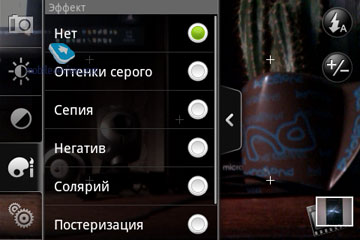
Exposure metering:
Besides these settings you can change contrast, saturation, shade and sharpness (five grade scale). You can turn off the shutter sound and the grid in the viewfinder mode, activate and use Geo Tags via GPS (when viewing the pictures you see the shooting location).
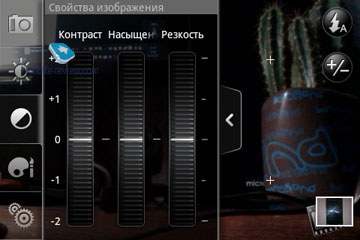
There is no Macro mode in the handset, but that doesn’t hinder its ability to shoot objects from 6-7 cm (1.5-2”). There are problems with text shooting. I don’t know why. Maybe I had a bad sample, but I managed to get a clear picture of the text ready for recognition only after having made a dozen attempts. Every time.
In the sample handset I discovered a problem that I saw earlier in other HTC devices - a pink spot on one part of a picture, in my case on the top half.
Picture quality under usual conditions can be evaluated from the samples below. I think the Legend makes photos about as good as HTC Desire – it is far from being a leader among 5 MPx smartphones, it is something in the middle or even below quality of pictures wise.
Photo samples (click to view the original):
Video
Video is recorded as MP4 or 3GP (mp4v or h.263 codecs) at 28 frames per second. Sound is recorded with samr codec.
For video the following resolutions are available:
- VGA – 640x480
- CIF – 352x288
- L – 320x240
Video settings repeat those for photo. You can turn On/Off sound recording, limit the recording duration or the size of a file.
You can use scaling at any resolution. During the recording the scaling option is not available, to change the scale you should stop. To see video quality take a look at the samples below.
Back to the table of contents >>>
Battery
HTC Legend comes with a 1300 mAh Li-Pol battery. According to the manufacturer it can provide up to 8 hours of talk time (GSM) and up to 440 hours (18 days) of standby. This information is exaggerated.

Under standard conditions (30-40 minutes of talk per day, 10-15 text messages, active Gmail and MS Exchanges accounts with push mail) my sample could give me a day and a half on average. Should you use the smartphone for music listening, loading Market apps somewhere on the go - the battery time drops to 12-14 hours. Compared to HTC Desire or Google Nexus One with their 8-9 hours this is really good, the device does not run out of charge in the middle of the day even if you use it a lot.
Back to the table of contents >>>
Performance
The smartphone is built on Qualcomm MSM 7227 platform and is powered by 600 MHz CPU. The Legend is armed with 384 MB of RAM with 100 MB being user accessible. Each app launched eats up about 2-5 MB of RAM, so if you have about a dozen of apps minimized, the device works quickly without slowdowns.
To download music, images, video and other user data, the current OS versions allow using memory cards only. For apps downloading, on contrary, only internal memory is available (512 MB total with 185 MB user accessible). This means that you are able to install about 30-35 medium sized apps.
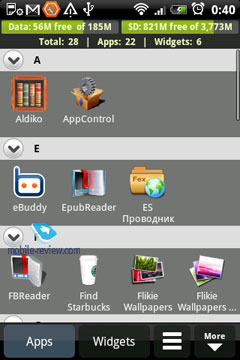
Now a word about video playback and general performance. The device doesn’t play back 1280x720 resolution video in any quality, but 720x420 resolution with 2 000 Kbps played without almost any slowdowns in ES Video Player (a part of ES File Manager) - only dynamic scenes suffered from barely noticeable dropped frames. In Meridian Video Player the same video played smoothly, without any dropped frames and slowdowns at all. I should mention that in the standard video player (album) video in 720x480 resolution didn’t launch. However we can say that the Legend copes well with video playback at 720x480 resolution with 2 000 Kbps record quality. And for the Legend’s display it is unconverted video according to all parameters, if we define “converting” as reducing the image size to the size of display resolution.
General interface operating rate is awesome, not a tiny delay or a hint of sluggishness. Compared to HTC Hero Legend’s interface just flies.

Back to the table of contents >>>
Connectivity
The smartphone in GSM (850/900/1800/1900) and UMTS (900/2100) networks. Both EDGE and HSDPA high speed data standards are supported. To activate or deactivate various connection modules you may use settings menu, standard or HTC designed widgets that can be assigned to the desktop.
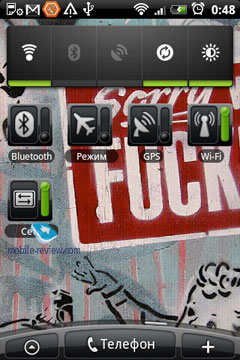
For PC synchronization and data transfer you can use the microUSB cable shipped with the handset. USB 2.0 is supported. It takes less than 2-3 seconds to copy a 10 MB file to a memory card in “Disk drive” mode. When the smartphone is connected to a PC you can choose one of the following modes: synchronization with HTC Sync, charging, data transfer to a memory card (“Disk drive”) or modem (to access internet via 2G/3G).
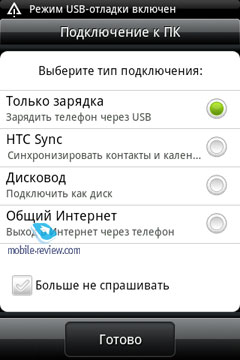
Built in Bluetooth 2.1+EDR supports the following profiles:
- Audio Gateway (AG) – the basic profile for headset
- Audio/Video Control Transport Protocol (AVCTP)
- Audio/Video Remote Control Profile (AVRCP) - control music playback via wireless headset
- Generic Audio/Video Distribution Profile (GAVDP)
- Audio/Video Distribution Transport Protocol (AVDTP)
- Advanced Audio Distribution Profile (A2DP) – stereo sound transfer via Bluetooth.
- Hands-Free Profile (HFP). Connection of Bluetooth-headset and handsfree device.
- Headset Profile (HSP). Connection of Bluetooth headset with the capability of performing simple functions – calls, answers, volume adjustment.
- File Transfer Profile (FTP). Provides access to the files on another device and access to the files on the phone from other devices
- Object Push Profile (OPP). A basic profile for sending "objects" such as pictures, virtual business cards, or calendar details.
Unlike in Hero, where only basic and some multimedia profiles were implemented, the Legend boasts OPP profile for object transfer (business cards, for instance) via Bluetooth and FTP profile providing access to file systems of other devices. The smartphone worked with the headset without a hassle, as usual. Using wireless stereo headset provides quite acceptable sound quality.
Wi-Fi (802.11b/g). The Legend was a solid performer as far as Wi-Fi is concerned. You can set the rules for the Wi-Fi turning to sleep mode, use static IP address for connection and add security certificates. While using Wi-Fi device almost doesn’t heat up.
Back to the table of contents >>>
Navigation
HTC Legend uses Qualcomm-based gpsOne chip. Presence or absence of navigation software depends on a market.
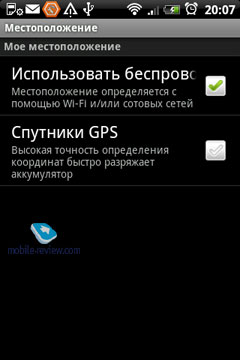
In any case the device will come with one navigation program preinstalled – Google Maps. Using it you can set the route (without voice directions), search for addresses using street names or Points Of Interest (cafes, restaurants, business names, etc). The main advantage of Google Maps over more functional navigation software is that the maps are loaded from the internet wherever you are, all big world cities are available. You will however need the internet connection and this is the main weakness of Google Maps as without the internet the app doesn’t work.
With my test sample the cold start of Navitel Navigator software took less than a minute, after that with each launch satellites were found in 10-15 seconds.
Back to the table of contents >>>
Sound
To my taste the Legend sounds neither better nor worse than HTC Desire or Google Nexus One. Should you listen to one of these devices or understand the sound they produce you can draw an analogy. Compared with the Hero the sound has become a little clearer, but I cannot explain what improved in particular - probably my perception of Legend’s sound in comparison with Hero’s was effected by Legend’s aluminum casing (smiling).

Back to the table of contents >>>
Software
The smartphone runs Android 2.1 OS with the latest version of HTC Sense UI. The same interface you can find in HTC Desire – you may read a detailed material about Sense that describes all functions of Android-based smartphones with this interface. The only thing distinguishing the Legend from the Desire is that the former is incapable of supporting live wallpapers. And even if you try to cheat and download the live wallpapers from the Market you will fail to install them as a background as there is no such option when choosing a picture for a desktop.
Back to the table of contents >>>
FM Radio
The Legend has FM radio. When first launched the frequencies are scanned automatically and a station list is created. New stations can be added manually with ability to assign a name for each one - the name will be displayed when the station is selected and in the general list.
Radio status and information are shown in the system bar. The radio can be played both via headphones and loudspeaker. The reception quality in my sample was far from being perfect, it was impossible to find a station in the room, I heard a lot of interference. To hear something on the selected frequency I had to take the device close to the window and to pull the headphones cord as high as possible. On the street I encountered no such problem, the stations were found correctly with only occasional interference. The radio works with the headset plugged in - it serves as an antenna.

Back to the table of contents >>>
Competition
HTC Desire. It is sad and funny at the same time, but the first and the main rival of a “legend” will be a “desire”. The difference in price is only 80 Euro. What would a customer get for these additional 80 Euro?
- Higher display resolution (800x480 vs. 320x480)
- Larger diagonal (3.7” vs. 3.2”)
- More RAM (576 MB vs. 384 MB)
- More powerful platform (1 GHz vs. 600 MHz)
Plus the ability to set live wallpapers for the desktop as an extra bonus.
Do all things mentioned cost more than extra 80 Euro? I think yes, for sure. The only Legend’s incontestable advantage over the Desire and any other smartphone is aluminum casing. Longer battery life also speaks in Legend’s favor.

Sony Ericsson X10. The X10 costs as much as the Legend. What does the X10 have against it?
As for the advantages of X10 I would mention higher resolution and larger diagonal display, but the display quality, I think, is inferior to that of the Legend, though the X10 has the reflective layer, a rarity for a touchscreen display. One more plus is a more powerful platform (Snapdragon with 1GHz vs. 600MHz in the Legend). Next advantage is 8 MPx camera with rather good photo and video quality plus 16 GB memory card included into the package.

Legend’s advantages over SE X10 are more compact dimensions, visually more expensive casing; in the whole the Legend looks more stylish then plastic X10, I can say it for sure being familiar with both devices. In the Legend the display is protected with glass, it cannot be scratched with keys, for instance; in the X10 we see simple plastic. In terms of comfort of use the Legend is hugely better than the X10, first of all thanks to Android 2.1 that looks more pleasant and is more comfortable in tiny things in comparison to 1.6. Secondly, due to HTC Sense that adds 10 more points to ease of use without exaggeration.
One more Legend advantage is better reception quality as well as better speakers. After all disputes about X10 microphone and speaker (they are bad. Or not bad) I have to confirm it. In the sample I got my hands on there are also problems when the person on the other end hears you badly or with unwanted noises, but sometimes there are no of such problems. There is no consistency. I have nothing to add.
Back to the table of contents >>>
Conclusion
The reception quality had no problems. The use of aluminum casing has not affected it, which could have been expected. Speech quality during the call is not bad, nothing more to say. The speaker has some extra volume left, under normal conditions (home, office) the maximum level is superfluous. Loudspeaker has medium volume, should you need a very loud ringtone you can select a tune from a standard set, most of them sound very loudly. Vibrating alert is medium or a bit stronger, when the device is in the jean pocket you feel it vibrating even while walking.

When I just met HTC Legend before the mobile congress in Barcelona, the device caused very warm feelings and seemed like something unusual against the background of other modern smartphones, most of which are look alikes. Now the way I look at the Legend changed not because of its similarity with HTC Hero. The reason is another Taiwanese manufacturer’s device – HTC Desire. If there was no such smartphone and in its place in Europe we had HTC EVO 4G, the HD2 analog running Android, the real flagship, the impressions from the Legend could have been totally different. But the Desire exists and it is available, and costs only 80 Euro more than the Legend. Now it is clear that it is with the Desire the company hit the jackpot - the device became popular immediately after the sales began.
Against the Desire background the Legend doesn’t look that much of a legend, it is just HTC Hero in aluminum case with two reasons that can get you to buy one. The first is if you are already using HTC Hero from its very first days and you became so close, all you need from a new device is the same Hero, just a bit updated. And the second one is that you are really eager to have a smartphone in the aluminum casing. Should one of the two reasons suit you, then HTC Legend is what you have been looking for; if not, but you are searching for an Android-based device, you’d better look towards the Desire. Taking into account all my love towards HTC I could not understand the logic of these two existing at the same time at the same place.
Technical specifications:
- Class: smartphone based on Android OS
- From factor: candy bar
- Rivals: HTC Desire, Sony Ericsson X10
- Body materials: aluminum, matte plastic (soft touch)
- OS: Android 2.1, HTC Sense UI
- Networks: GSM/EDGE 850/900/1800/1900 MHz, UMTS/HSDPA 900/2100
- Platform Qualcomm MSM7227, 600 MHz CPU
- RAM: 384 MB
- Data storage memory: 512 MB + microSD slot
- Interfaces: Wi-Fi, Bluetooth 2.1+EDR (A2DP), microUSB (USB 2.0) slot for charging/synchronization, 3.5 mm jack for headset
- Display: AMOLED, capacitive, 3.2” diagonal with 480x320 resolution (HVGA), automatic brightness adjustment
- Camera: 5 MPx with autofocus and flash, VGA video capture
- Navigation: GPS on Qualcomm gpsOne chip (A-GPS support)
- Additionally: FM radio, accelerometer, light sensor, proximity sensor
- Battery: removable 1300 mAh Li-Ion
- Dimensions: 112 x 56.5 x 11. mm
- Weight: 126 g.
Do you want to talk about this? Please, go to our Forum and let your opinion to be known to the author and everybody else.
Back to the table of contents >>>
Artem Lutfullin ([email protected])
 Twitter Twitter
Published - 20 May 2010.
Having something to add?! Write us... [email protected]
|
